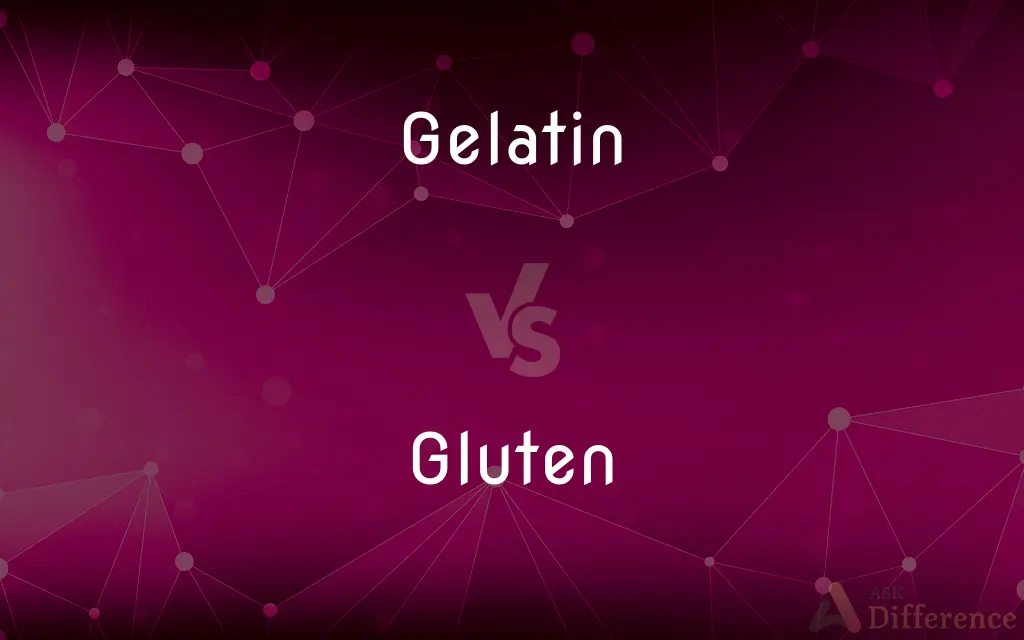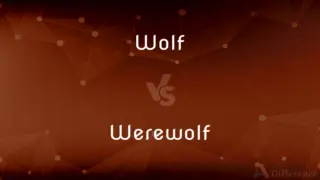Gelatin vs. Gluten — What's the Difference?
Edited by Tayyaba Rehman — By Maham Liaqat — Updated on March 18, 2024
Gelatin is a protein derived from animal collagen, used as a gelling agent; gluten is a plant-based protein found in wheat, acting as a binding agent in baking.

Difference Between Gelatin and Gluten
Table of Contents
ADVERTISEMENT
Key Differences
Gelatin is sourced from the collagen found in animal bones, skin, and connective tissues and is widely used in food products, pharmaceuticals, and cosmetics for its ability to gel and stabilize. Gluten, on the other hand, is a protein composite found in wheat and related grains, including barley and rye. It gives elasticity to dough, helping it rise and maintain its shape, and often results in the chewy texture of baked products. While gelatin is celebrated for its gelling properties in desserts and jellies, gluten is prized in baking for its unique textural properties.
The dietary restrictions surrounding gelatin and gluten differ significantly. Gelatin, being animal-derived, is not suitable for vegetarians or vegans and may also be subject to religious dietary laws. Gluten is a concern for individuals with celiac disease or gluten sensitivity, as it can cause health issues ranging from discomfort to severe digestive disorders in these groups. Thus, while gelatin's use may be restricted based on dietary preferences or religious beliefs, gluten's restriction is typically due to health reasons.
In culinary applications, gelatin is used to thicken or solidify a wide range of dishes, from gummy candies to mousses and gelatin desserts. It is also used in some dairy products and to clarify beverages. Gluten's culinary uses are centered around its role in baking and pasta making, where it provides dough with its stretchy, airy quality. Both proteins are integral to their respective culinary niches, but they cater to very different needs and preferences.
From a nutritional perspective, both gelatin and gluten offer protein, but their amino acid profiles differ. Gelatin is rich in glycine, proline, and hydroxyproline, which are less common in other protein sources and have various health benefits, including potential support for skin, hair, nail health, and joint health. Gluten's nutritional value is more akin to that of other plant-based proteins, providing a source of protein primarily in diets that include grains.
The debate over health impacts further distinguishes gelatin and gluten. Gelatin is often touted for its health benefits, particularly for joint and skin health, due to its unique amino acids. However, gluten has been the subject of health concerns, particularly for those with celiac disease or non-celiac gluten sensitivity, for whom gluten consumption can lead to serious health issues. For the general population without gluten sensitivities, gluten is typically harmless and is a regular part of a balanced diet.
ADVERTISEMENT
Comparison Chart
Source
Animal collagen (bones, skin)
Wheat and related grains (barley, rye)
Dietary Restrictions
Not suitable for vegetarians/vegans, some religious restrictions
Avoided by those with celiac disease or gluten sensitivity
Culinary Uses
Gelling agent in desserts, candies, pharmaceuticals
Elasticity and texture in bread, pasta
Nutritional Profile
Rich in specific amino acids (glycine, proline)
Protein source, similar to other grains
Health Impacts
Beneficial for joint, skin health
Can cause health issues in sensitive individuals
Compare with Definitions
Gelatin
A clear, tasteless protein used as a thickener or stabilizer.
Gelatin is essential for making jellied desserts.
Gluten
A protein that gives dough its elasticity.
Gluten traps air bubbles, allowing bread to rise.
Gelatin
Used in various industries beyond food.
Gelatin capsules are a common form of medication delivery.
Gluten
Can cause health issues for certain individuals.
Gluten sensitivity can lead to digestive discomfort and fatigue.
Gelatin
Often found in photographic processes.
Gelatin is used in the coating of photographic films and papers.
Gluten
Found in wheat, barley, and rye.
People with celiac disease must avoid gluten in these grains.
Gelatin
Can be used as a clarifying agent in beverages.
Winemakers sometimes use gelatin to clarify wine.
Gluten
The basis for seitan, a vegan protein source.
Seitan is made by washing wheat flour dough to concentrate the gluten.
Gelatin
Derived from boiling animal parts.
The production of gelatin involves processing collagen from beef or pork.
Gluten
Integral to the texture of baked goods.
The chewy texture of bagels is due to their high gluten content.
Gelatin
Gelatin or gelatine (from Latin: gelatus meaning "stiff" or "frozen") is a translucent, colorless, flavorless food ingredient, commonly derived from collagen taken from animal body parts. It is brittle when dry and gummy when moist.
Gluten
Gluten is a group of seed storage proteins found in certain cereal grains. Although, strictly speaking, "gluten" pertains only to wheat proteins, in the medical literature it refers to the combination of prolamin and glutelin proteins naturally occurring in all grains that have been demonstrated capable of triggering celiac disease.
Gelatin
A colorless or slightly yellow, transparent, brittle protein formed by boiling the specially prepared skin, bones, and connective tissue of animals and used in foods, drugs, and photographic film.
Gluten
The mixture of proteins, including gliadins and glutelins, found in wheat grains, which are not soluble in water and which give wheat dough its elastic texture.
Gelatin
Any of various similar substances.
Gluten
Any of the prolamins found in cereal grains, especially the prolamins in wheat, rye, barley, and possibly oats, that cause digestive disorders such as celiac disease.
Gelatin
A jelly made with gelatin, used as a dessert or salad base.
Gluten
(obsolete) Fibrin (formerly considered as one of the "animal humours").
Gelatin
A thin sheet made of colored gelatin used in theatrical lighting. Also called gel.
Gluten
(rare) Any gluey, sticky substance.
Gelatin
A protein derived through partial hydrolysis of the collagen extracted from animal skin, bones, cartilage, ligaments, etc.
Gluten
The major protein in cereal grains, especially wheat; responsible for the elasticity in dough and the structure in baked bread.
Gelatin
An edible jelly made from this material.
Gluten
(geology) A gluey, sticky mass of clay, bitumen etc.
Gelatin
A thin, translucent membrane used as a filter for photography or for theatrical lighting effects.
Gluten
The viscid, tenacious substance which gives adhesiveness to dough.
Gelatin
Animal jelly; glutinous material obtained from animal tissues by prolonged boiling. Specifically (Physiol. Chem.), a nitrogeneous colloid, not existing as such in the animal body, but formed by the hydrating action of boiling water on the collagen of various kinds of connective tissue (as tendons, bones, ligaments, etc.). Its distinguishing character is that of dissolving in hot water, and forming a jelly on cooling. It is an important ingredient of calf's-foot jelly, isinglass, glue, etc. It is used as food, but its nutritious qualities are of a low order.
Gluten
A protein substance that remains when starch is removed from cereal grains; gives cohesiveness to dough
Gelatin
A colorless water-soluble glutinous protein obtained from animal tissues such as bone and skin
Gelatin
An edible jelly (sweet or pungent) made with gelatin and used as a dessert or salad base or a coating for foods
Gelatin
A thin translucent membrane used over stage lights for color effects
Common Curiosities
Why is gluten important in baking?
Gluten provides elasticity and strength to dough, allowing it to rise and maintain its shape, which is crucial for the texture of baked goods.
Can vegetarians consume gelatin?
No, vegetarians and vegans typically avoid gelatin because it is derived from animals.
What is gelatin made of?
Gelatin is made from animal collagen, obtained from bones, skin, and connective tissues.
How do gelatin and gluten differ nutritionally?
Gelatin is notable for its unique amino acids beneficial for skin and joint health, while gluten provides protein similar to other grains but can be harmful to individuals with certain sensitivities.
What are the health concerns associated with gluten?
Gluten can cause health problems such as digestive issues and serious autoimmune reactions in people with celiac disease or gluten sensitivity.
Are there substitutes for gelatin and gluten in cooking?
Yes, agar-agar and pectin can substitute for gelatin, while gluten-free flours and binding agents like xanthan gum can replace gluten for those with sensitivities.
How are gelatin and gluten sourced?
Gelatin is sourced from animals, while gluten is sourced from specific grains like wheat, barley, and rye.
Is it possible to be allergic to gelatin or gluten?
Yes, allergies to both substances are possible, with gluten allergies being particularly noted in the context of wheat allergies and celiac disease.
Can gelatin and gluten be used together?
In culinary practices, they are used in completely different contexts and rarely, if ever, used together due to their distinct functions—gelatin in gelling and gluten in baking.
What is a gluten-free diet?
A gluten-free diet excludes all forms of gluten, primarily for individuals with celiac disease, wheat allergy, or gluten sensitivity, to avoid health issues.
What are some common products that contain gelatin?
Gelatin is commonly found in jellied desserts, marshmallows, capsules, and as a clarifying agent in wines and juices.
Can gelatin benefit health?
Yes, gelatin is associated with several health benefits, including support for joint health, digestion, and skin elasticity.
Share Your Discovery

Previous Comparison
Wolf vs. Werewolf
Next Comparison
Promoter vs. OperatorAuthor Spotlight
Written by
Maham LiaqatEdited by
Tayyaba RehmanTayyaba Rehman is a distinguished writer, currently serving as a primary contributor to askdifference.com. As a researcher in semantics and etymology, Tayyaba's passion for the complexity of languages and their distinctions has found a perfect home on the platform. Tayyaba delves into the intricacies of language, distinguishing between commonly confused words and phrases, thereby providing clarity for readers worldwide.














































